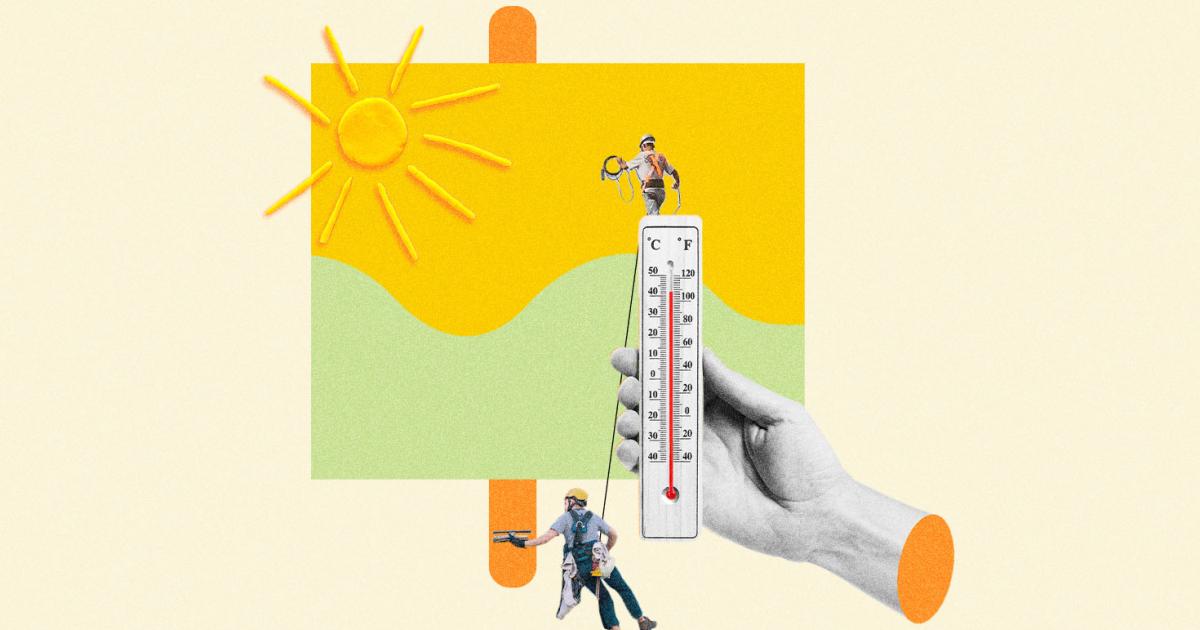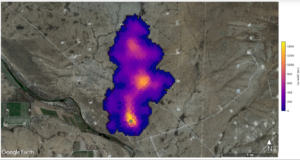
The world just cataloged the hottest month in recorded history. For weeks, U.S. headlines have heralded scorching heat waves from Rio Grande Village in Texas to Phoenix, which sweated through 31 days of record-breaking temperatures above 118 degrees Fahrenheit. Last month, more than 75 million Americans were living under extreme heat advisories — more than 6.5 billion people experienced these conditions worldwide, according to data from Climate Central.
The human toll has been devastating: Dozens of related deaths are suspected in Arizona alone — although that’s probably an undercount and it’s far short of the 61,000 Europeans who lost their lives in 2022 heat waves.
The economic impact is also chilling: billions of dollars in lost worker productivity, especially in agriculture, construction, manufacturing and certain service industries. The infrastructure risks are simmering below the service, such as buckling railway lines (just ask the U.K.) or overheating electric grids.
"What we are learning is that hotter temperatures tend to muck up the gears of the economy in many more ways than we would have expected," environmental and labor economist R. Jisung Park told The New York Times.
That’s where sustainability professionals come in. Your job is no longer just about climate mitigation, it’s about climate adaptation. With awareness of heat-related issues at an all-time high, it’s time to get senior executives on board with strategies that treat heat-related climate risks with as much respect as hurricanes, tornadoes, cyclones and other extreme weather events.
"Heat is really deadly and destructive, and we’ve never treated it that way as a society," said Juanita Constible, senior climate and health advocate with the climate adaption team at the Natural Resources Defense Council. "It’s been socially invisible."
Adopt policies that keep workers safe
It may surprise you to learn there are no official federal requirements covering how to protect employees from extreme heat — yet thousands of outdoor and indoor workers become sick from "occupational heat exposure," according to the Occupational Health and Safety Administration (OSHA).
Public advocacy groups began lobbying OSHA to move on this issue in the Nixon administration, but those efforts were ignored and it wasn’t until 2021 that the agency began an official rulemaking after the heat dome in the Pacific Northwest.
Constible predicted it will take several years before the heat standard is finalized, simply because that’s how the process works. Meanwhile, President Joe Biden is pushing for the adoption of emergency measures, and OSHA last week issued a heat "hazard alert." Five states officially have heat policies — California, Colorado, Minnesota, Oregon and Washington — although they vary dramatically. Another, Texas, recently banned mandated worker water breaks adopted in cities including Austin and Dallas.
Tips to get started
Juley Fulcher, worker health and safety advocate with the Congress Watch team at nonprofit Public Citizen, offered specific recommendations to employers that build on the OSHA ideas:
- Provide cool water, shade and rest breaks on a periodic basis. A good rule of thumb is to ensure at least 1 liter of water is available per worker per hour, Fulcher suggested. Paid breaks should happen in a cool space, at the very least in a shaded area with misting fans or other cooling devices. (There are now many solar-powered options.) The Centers for Disease Control offers a guide for schedules. Alongside this policy, employers should to provide adequate, safe access to restroom facilities.
- Give workers, especially new ones, time to acclimate. Most heat-related deaths on the job occur among new employees during their first week on the job, Fulcher said, adding that they need to become used to the conditions. Another strategy might be to change shift timing, so that workers aren’t subjected to the most brutal heat of the day.
- Train all employees to understand warning signs of heat stress and how to act on them. A company policy for heat should include considerations such as the temperatures and humidity considerations that trigger special measures, Fulcher said. It should include regular check-ins with employees and clear instructions on what steps to take to stabilize individuals and get medical help should someone succumb on the job. That includes those who are in the field or who might be working remotely in a home that doesn’t have air-conditioning or another cooling system.
"We recognize that every workplace is different, and that is why you need a workplace plan that is specific to your situation," Fulcher said.
Here are more resources that sustainability teams might find valuable in developing and following through on these strategies:
- A short guide co-authored by NRDC’s Constible for assessing and planning for the effects of climate change on workers.
- This manual for contemplating your company’s preparedness for "total worker health."
- This heat safety app from OSHA and CDC, which provides weather-related guidance companies can use to trigger their plans.
How is your corporate sustainability team planning for a future of extreme heat? Send specific ideas to [email protected].
- SEO Powered Content & PR Distribution. Get Amplified Today.
- PlatoData.Network Vertical Generative Ai. Empower Yourself. Access Here.
- PlatoAiStream. Web3 Intelligence. Knowledge Amplified. Access Here.
- PlatoESG. Automotive / EVs, Carbon, CleanTech, Energy, Environment, Solar, Waste Management. Access Here.
- BlockOffsets. Modernizing Environmental Offset Ownership. Access Here.
- Source: https://www.greenbiz.com/article/its-companies-protect-workers-extreme-heat-heres-how-adapt
- :has
- :is
- :where
- $UP
- 000
- 1
- 2021
- 2022
- 22
- 31
- 75
- a
- About
- above
- access
- According
- Act
- adapt
- adaptation
- adding
- administration
- adopted
- Adoption
- advocacy
- advocate
- After
- agency
- agriculture
- Alert
- All
- alone
- alongside
- also
- Although
- Americans
- among
- an
- and
- Another
- ARE
- AREA
- arizona
- AS
- Assessing
- At
- austin
- available
- awareness
- basis
- BE
- because
- become
- been
- before
- began
- below
- biden
- Billion
- billions
- board
- breaks
- build
- but
- by
- CA
- cambridge
- CAN
- CDC
- Centers
- certain
- change
- Cities
- citizen
- clear
- Climate
- Climate change
- Colorado
- come
- Companies
- company
- Company’s
- conditions
- Congress
- considerations
- construction
- control
- Cool
- cooling system
- Corporate
- Council
- covering
- Dallas
- day
- Days
- deaths
- Defense
- devastating
- developing
- Devices
- different
- Disease
- Doesn’t
- dollars
- dramatically
- during
- Economic
- Economic Impact
- Economist
- economy
- effects
- efforts
- Electric
- emergency
- employees
- employers
- ensure
- environmental
- especially
- Ether (ETH)
- events
- Every
- executives
- expected
- experienced
- Exposure
- extreme
- facilities
- fans
- far
- Federal
- field
- finalized
- Find
- First
- five
- following
- For
- from
- future
- gears
- get
- good
- Group’s
- guidance
- guide
- happen
- Have
- Headlines
- Health
- help
- High
- Home
- hottest
- hour
- How
- How To
- HTML
- HTTPS
- human
- ideas
- Impact
- in
- include
- includes
- Including
- individuals
- Indoor
- industries
- Infrastructure
- instructions
- issue
- Issued
- issues
- IT
- Job
- joe
- Joe Biden
- jpg
- just
- Keep
- labor
- Last
- LEARN
- learning
- least
- lines
- Lives
- living
- lobbying
- longer
- lost
- manufacturing
- many
- May..
- Meanwhile
- measures
- medical
- might
- million
- mitigation
- Month
- more
- most
- move
- much
- Natural
- Need
- never
- New
- New York
- Nixon
- no
- Nonprofit
- now
- occupational
- occur
- of
- offered
- Offers
- official
- Officially
- on
- ones
- or
- Oregon
- Other
- Outdoor
- Pacific
- paid
- Park
- People
- per
- periodic
- plan
- planning
- plans
- plato
- Plato Data Intelligence
- PlatoData
- policies
- policy
- predicted
- president
- president joe biden
- probably
- process
- productivity
- professionals
- protect
- protected
- provide
- provides
- public
- Pushing
- R
- Railway
- really
- recognize
- recommendations
- recorded
- regular
- related
- Requirements
- Resources
- respect
- REST
- risks
- Rule
- s
- safe
- Safety
- Said
- send
- senior
- service
- several
- shift
- Short
- should
- Signs
- simply
- situation
- So
- socially
- Society
- Someone
- Space
- special
- specific
- stabilize
- standard
- States
- Steps
- strategies
- Strategy
- stress
- such
- surprise
- suspected
- Sustainability
- system
- Take
- team
- teams
- texas
- than
- that
- The
- their
- Them
- There.
- These
- they
- this
- those
- thousands
- Through
- time
- timing
- to
- Total
- treat
- treated
- trigger
- u.s.
- under
- understand
- until
- usda
- use
- used
- Valuable
- very
- Village
- warning
- Watch
- Water
- waves
- Way..
- ways
- we
- Weather
- week
- Weeks
- were
- What
- which
- WHO
- why
- will
- with
- worker
- workers
- working
- working remotely
- Workplace
- works
- world
- worldwide
- would
- years
- yet
- york
- you
- Your
- zephyrnet









